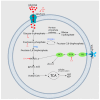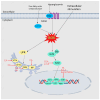Research Progress on the Mechanism for Improving Glucose and Lipid Metabolism Disorders Using Phenolic Acid Components from Medicinal and Edible Homologous Plants
- PMID: 39459158
- PMCID: PMC11510019
- DOI: 10.3390/molecules29204790
Research Progress on the Mechanism for Improving Glucose and Lipid Metabolism Disorders Using Phenolic Acid Components from Medicinal and Edible Homologous Plants
Abstract
Glucose and lipid metabolism disorders are the core pathological mechanism of a variety of metabolic diseases, and the incidence of related diseases is increasing year by year, which seriously threatens human life and health. Traditional Chinese medicine with medicinal and edible properties refers to Chinese medicinal resources that have both medicinal and edible characteristics. Due to its safety and its health-promoting and medicinal functions, traditional Chinese medicine has received increasing attention in the development of functional health foods. Phenolic acids are important secondary metabolites that are ubiquitous in medicinal and edible homologous plants, and the regulation of glycolipid metabolism is an important activity and plays a key role in many diseases. In this paper, we focus on the alleviation of glycolipid disorders using MEHH phenolic acids, which regulate glucose metabolism and lipid metabolism, improve insulin resistance, inhibit inflammatory responses, alleviate oxidative stress, and regulate intestinal flora; additionally, we summarize the mechanism in order to provide a reference for MEHH phenolic acids in the treatment of glycolipid metabolism diseases.
Keywords: glycolipid metabolism; homology of medicine and food; plant phenolic acids.
Conflict of interest statement
The authors declare no conflicts of interest.
Figures







Similar articles
-
Phenolic acids from medicinal and edible homologous plants: a potential anti-inflammatory agent for inflammatory diseases.Front Immunol. 2024 Jun 21;15:1345002. doi: 10.3389/fimmu.2024.1345002. eCollection 2024. Front Immunol. 2024. PMID: 38975345 Free PMC article. Review.
-
Polysaccharides in Medicinal and Food Homologous Plants regulate intestinal flora to improve type 2 diabetes: Systematic review.Phytomedicine. 2024 Nov;134:156027. doi: 10.1016/j.phymed.2024.156027. Epub 2024 Sep 3. Phytomedicine. 2024. PMID: 39270592
-
Antioxidant activities of selected Chinese medicinal and edible plants.Int J Food Sci Nutr. 2011 Aug;62(5):441-4. doi: 10.3109/09637486.2010.547178. Epub 2011 Mar 4. Int J Food Sci Nutr. 2011. PMID: 21375389
-
Antidiabetic Effects of Simple Phenolic Acids: A Comprehensive Review.Phytother Res. 2016 Feb;30(2):184-99. doi: 10.1002/ptr.5528. Epub 2015 Dec 4. Phytother Res. 2016. PMID: 26634804 Review.
-
Recent advances in medicinal and edible homologous plant polysaccharides: Preparation, structure and prevention and treatment of diabetes.Int J Biol Macromol. 2024 Feb;258(Pt 2):128873. doi: 10.1016/j.ijbiomac.2023.128873. Epub 2023 Dec 21. Int J Biol Macromol. 2024. PMID: 38141704 Review.
Cited by
-
Regulatory Mechanisms of Phenolic Acids in Metabolic Dysfunction-Associated Steatotic Liver Disease: A Review.Antioxidants (Basel). 2025 Jun 20;14(7):760. doi: 10.3390/antiox14070760. Antioxidants (Basel). 2025. PMID: 40722864 Free PMC article. Review.
-
Phenolic Acids from Fruit By-Products as Therapeutic Agents for Metabolic Syndrome: A Review.Int J Mol Sci. 2025 Apr 18;26(8):3834. doi: 10.3390/ijms26083834. Int J Mol Sci. 2025. PMID: 40332518 Free PMC article. Review.
References
Publication types
MeSH terms
Substances
Grants and funding
LinkOut - more resources
Full Text Sources

